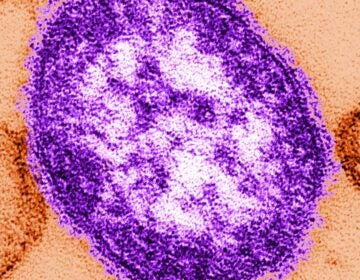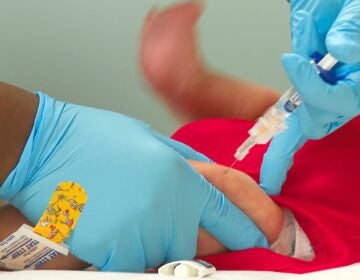Philly area health officials are seeing cases of dengue fever among travelers as outbreaks grow abroad
More than 3,290 cases of dengue fever have been reported in the U.S. and its territories, with more than half of cases occurring in Puerto Rico.

Close up of Aedes Aegypti Mosquito resting on the leaf in garden. Aedes is a genus of mosquitoes transmit serious diseases, including dengue fever, yellow fever, the Zika virus and chikungunya. (Poravute Siriphiroon/BigStock)
From Philly and the Pa. suburbs to South Jersey and Delaware, what would you like WHYY News to cover? Let us know!
Parts of the world are experiencing particularly severe outbreaks of dengue fever this year, and it’s causing a rising number of infections among United States travelers this summer.
The mosquito-borne disease is not endemic to the U.S., but there have been more than 1,000 cases of dengue reported in 45 states and the District of Columbia, and another 2,209 cases in Puerto Rico, according to the Centers for Disease Control and Prevention.
With travel season in full swing, dengue fever cases have made their way to the tri-state region. Delaware has recorded six cases, New Jersey 56 and Pennsylvania 31.
Seven people in Chester County, Pennsylvania, have so far tested positive. Everyone with infections had recently been to places like Argentina, Barbados, Dominican Republic, Honduras, the Netherlands Antilles islands and the Philippines.
“If you travel to a country where there’s a high incidence of dengue, you come home and you have any symptom whatsoever, it is best to get to the doctor right away,” said Nancy Sullivan, supervisor of the disease investigation and surveillance program at Chester County Health Department. “You may think it’s a common cold and it isn’t.”
Dengue fever is a viral disease sometimes called “breakbone fever” for the intense body and muscle pain it can cause in severe cases. About one in four people who are exposed to the virus will become ill and have symptoms that can include fever, headache, muscle pains, pain behind the eyes and a rash.
Sullivan said checking in with a medical provider can lead to a test that can confirm a dengue infection. While there is no specific treatment for the disease, a positive test result could make someone eligible for a dengue vaccine to prevent a subsequent infection.
It also gives public health experts opportunities to better track changes in diseases and how they are affecting communities both locally and globally, Sullivan said.
“People travel internationally all the time and then come into the U.S. and come into Chester County,” she said. “We are a small county in Pennsylvania, but we have to pay attention to what’s going on in the world.”
Why cases are on the rise
Infectious disease and environmental health experts say climate change that causes more rain and hotter spring and summer months could lead to a larger population of infected mosquitoes each year, putting even more people and travelers at risk of illness.
“When we talk about these diseases that are accelerated by changing climate, it’s more than just that,” said Dr. Esther Chernak, infectious disease expert at Drexel University. “It’s also demographic factors, population shifts, migration, urbanization – things that foster the spread of these viruses from one part of the globe to another.”
While most people recover on their own from mild illness, some people become hospitalized with low blood pressure and bleeding from the nose or in the gastrointestinal tract, Chernak said.
Dengue isn’t contagious from person to person, but people can contract it from bites of mosquitoes that carry any of the four strains of dengue virus. This species of mosquito – Aedes aegypti – is also known for spreading chikungunya, Zika fever, Mayaro and yellow fever viruses.
The insects are commonly found in countries with tropical or warmer climates, but they’ve also appeared and caused small local disease outbreaks in Florida, Hawaii, Texas, Arizona and California.
Most people in the U.S. who’ve contracted dengue this year have traveled internationally, data show.
Health experts recommend that people take precautions before traveling to places with outbreaks of dengue, like packing mosquito spray repellent and long-sleeved shirts and pants to ward off insect bites.
At the public health level, Chernak said boosting investments in community programs that monitor mosquito-borne illnesses should be a priority now and in the coming years.
“One of the challenges I think for these activities, whether it’s human surveillance or mosquito surveillance and control, is that many of these activities occur at the local level and they’re funded by local dollars,” she said, “Which are often insufficient to do the work that needs to be done.”

Get daily updates from WHYY News!
WHYY is your source for fact-based, in-depth journalism and information. As a nonprofit organization, we rely on financial support from readers like you. Please give today.





